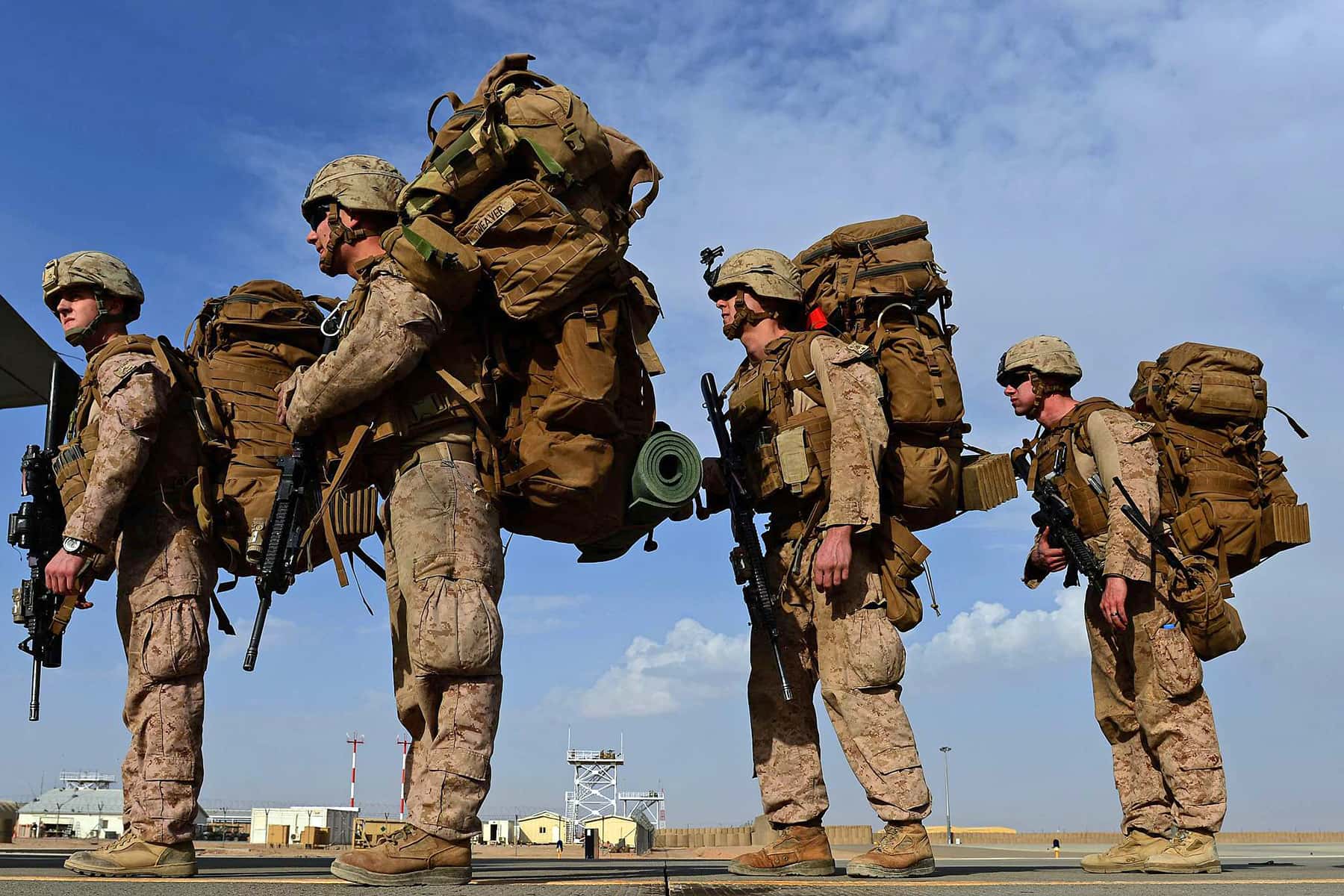
The maudlin news coverage of how the U.S. botched the exit from Afghanistan will go on for months, maybe years. It will do as much good as rubbernecking a wreck on the side of the road to prevent it from having happened. The awkward exit from the country should not be confused with the loss of the War, and it is the loss that needs to be weighed.
To understand that loss and what we might learn from it, we have to go back to before the time when the U.S. was even a country. It is there that we locate the cultural DNA that drove the invasion of Afghanistan in the first place. Then, we need to update our understanding to the current context. Only then, with knowledge of both past and present, can we make an informed judgement about the loss of the War.
The British colonies that eventually became the U.S. were inextricably bound up in genocide and slavery. That is a commonplace. Less well understood is that they were also agents of imperialism. The Europeans and their white descendants killed more than 50 million Native Americans to subdue the continent. It was “the worst human holocaust the world had ever witnessed” and as pure an act of both genocide and imperialism as has ever been accomplished.
Yes, it was dressed up in the sociological fig leaves of “Manifest Destiny” and “bringing civilization to the savages,” but it was inescapably an act of mass murder and pillage by an industrial-age civilization exterminating and expropriating the land from a people still living in the stone age. That is not a value judgement, but a statement of fact.
And it was wildly successful for the U.S. and its white rulers. In 1800, huddled on the Eastern seaboard, the U.S. economy generated about 1.5% of global GDP. In 1900, by then spanning the continent, it was 20% of a nine-times larger number, making the U.S. the largest economy on earth.
By then, the pacification of the continent was complete and the imperialist imperative was just finding its legs. In 1898, the U.S. moved abroad to seize Cuba, Puerto Rico, Guam, and the Philippines in the Spanish-American War. It was in the grand imperial tradition of European and descendant countries that controlled almost 90% of the land mass on earth.
Over following decades, the U.S. overthrew governments in Haiti, British Guiana, Columbia, Nicaragua, El Salvador, Panama, Bolivia, Guatemala, Honduras, and other nations. This was under the cover of another rhetorical fig leaf, the Monroe Doctrine, by which the U.S. claimed suzerainty over all nations in the Western Hemisphere. It was unadorned imperialism through and through.
In World War I, the nations of Europe blew their own brains out, with the consequence that the center of global power that had resided in Europe for the prior 400 years shifted to the U.S. By the end of World War II, just 25 years later, the U.S. stood astride the world as a colossus among pigmies, with a greater asymmetry of power over all other nations than had ever existed in the history of the world. It resumed its manifestly imperialist destiny with a vengeance.
Between 1945, at the end of World War II, and 1991, at the end of the Cold War, the U.S. invaded or carried out coups in more than 50 countries. Some are notorious: Cuba, Iran, Vietnam, Cambodia, Laos, Chile, etc. Many are less renowned: Bulgaria, Fiji, Suriname, Seychelles, Zaire, Chad, Congo, and others.
That was the essence of the Cold War: it was the greatest imperialist land grab in the history of the world. It wasn’t about Europe. It was about who was going to pick up the more than 100 colonies around the world that had formed the substance of the European Empires, three centuries in the making, but that European states could no longer control, having exhausted themselves in two suicidal civil wars in less than a generation. The U.S. was determined that it was going to sweep those former colonies into its orbit, and milk them the same way the Europeans had, to their staggering enrichment.
The Soviet Union made itself available to help developing world countries that wanted to resist domination by a new Western imperial master. Think China, India, Cuba, Vietnam, Nicaragua, and others. This is why the Cold War was cold: the U.S. (as the “first” world) and the Soviet Union (as the “second”) fought over “third” world countries, backing this one or that, but never coming directly to blows with one another.
So, the U.S. imperialist imperative is both genetic—rooted in its very founding, and opportunistic, the result of massive successes over centuries that have unfathomably enriched the U.S. and its ruling elites. The current context is also instructive.
On the fall of the Soviet Union, in 1991, U.S. elites were swept up in the hubristic euphoria of another 1945-like unipolar moment. Once again, the country had no effective military challengers anywhere in the world. George H.W. Bush declared “A New World Order.” And, indeed, it was.
The problem was that the lack of a meaningful military challenger anywhere in the world meant that the trillions of dollars sluiced to the Pentagon and the weapons makers (and, indirectly to Congress members via industry lobbyists) over the 45-year duration of the Cold War no longer had any rationale. There was literally nobody left standing to fight. Naive but well-meaning progressives fantasized about a “peace dividend” coming due. How little they knew about how power in Washington actually works.
Instead, the neo-con Project for a New American Century seized on the fact of A New World Order and foretold a regime of U.S. global domination that could never be challenged. It declared the need for “a new Pearl Harbor” that would galvanize the will of the American people to cement its military dominance over all other nations, forever. The 9/11 event came along on schedule, as needed, and the U.S. began its campaign to dominate the world under the color of yet another rhetorical fig leaf, the Global War on Terror.
It is impossible to understand Afghanistan, or Iraq for that matter, without understanding this context. If the U.S. didn’t have those wars there would be no rationale for the torrential spending the Military Industrial Complex has come to demand and that Eisenhower rightly decried when he named it, 60 years ago, in 1961. And it isn’t only the military industry. The media, too, benefits from wars and the higher ratings they command.
It’s not an accident that the wealthy elites who own the military industry also own the media. Nor is it a coincidence that the talking heads the media uses to plump for perpetual war always come from the ranks of retired military brass, many of whom serve as advisers or board members to weapons makers and military contractors. It is as incestuous a conflict against the public interest as could be conceived, but it works, for them, anyway.
The proof of these insidious incentives are both financial and kinetic. Average Defense Department spending fell from a Cold War average of $458 billion per year before 1991, to “only” $394 billion per year under the Clinton administration. But after 9/11, spending jumped to $601 billion a year, $200 extra billion dollars a year, just like that. The kinetic facts are equally revealing.
The Taliban were defeated within the first year of the U.S. invasion, in 2001. The U.S. could have left then had the putative rationale for the War been true. But it stayed for another 19 years, reliably draining $2.26 trillion from the American taxpayer. Similarly with Iraq. Its purported rationale was a notorious lie from the outset and it was known within weeks of the invasion that it did not have the WMDs on which the invasion had been predicated. It didn’t matter. The U.S. is still there, 18 years and $6 trillion later.
But something had changed along the way. Decades before, right after World War II, developing world nations had begun to resist their colonial occupiers, and win. Indonesia fought and won a vicious war to escape colonial domination by the Dutch. Kenya fought a 7-year war to gain its freedom from the British. Algeria defeated the French in a war so tumultuous it brought down the French government. Angola ousted the Portuguese.
And, of course, Vietnam gained its freedom from its American imperial occupiers after the most brutal, protracted war in the post-War period. Vietnam is so singular an event in the U.S.’ habit of willfully not learning the lessons of its losses that an additional word about it is necessary.
Vietnam pitted the mightiest country on earth against an iron-age nation that had not even entered the industrial age. The U.S. dropped 12 million tons of bombs on Vietnam, four times the tonnage of all the bombs dropped in all theaters of World War II, combined. It killed more than 4 million people in a nation that had not attacked it, had no desire to attack it, and no capacity to do so. It spent $168,000 for every enemy combatant killed, at a time when the average annual Vietnamese income was $80. Yet it lost. Why?
The Vietnamese had learned from the Indonesian, Kenyan, Algerian, and Angolan experiences. They knew they could not go toe-to-toe with U.S. firepower. So, they fought a war of enervation, tiring the Americans of the will to fight. They fought opportunistically, harassing the enemy whenever they could and only engaging when they were assured of winning. Ho Chi Minh, the leader of North Vietnam, sagely predicted, “The Americans will tire of their losses and will eventually go home.” They did. And they did. The Taliban learned this lesson, too. The U.S. military did not.
The morale factor is also critical to understanding these failed wars. Napoleon famously observed, “The moral is to the material as three is to one.” The Viet Cong infiltrated the South Vietnamese army so they knew the order of battle before every engagement was even begun. This assured that the battles would be ambushes and greatly demoralized the South Vietnamese soldiers who refused to even go out to the field of battle and fight. An identical dynamic played itself out in Afghanistan and it’s easy to understand why.
Soldiers don’t like to see their own country and people violated, no matter how much they’re being paid. They despise their own government for accepting the billions of dollars in bribes that the U.S. routinely dispenses to convert high officials into pliable puppets. Soldiers especially hate the patronage that installs useless cronies in high positions in the military because it endangers real soldiers’ lives. Yet all of those means of undermining morale are integral to the way the U.S. conducts its imperial affairs.
You can see the effects in the way the Afghan military evaporated like clouds in the summer sun before the approaching Taliban advances. The South Vietnamese army did the same when the North began its march on the South in the spring of 1975. Morale matters greatly in war but demoralization of puppet regime armies is baked into the very way U.S. imperialism operates and the results are entirely predictable.
This is where we are today. The U.S. is driven to foreign invasions because of its genetic predisposition, its centuries of success and enrichment from imperialism, and because of the staggering sums that are transferred to the military, media and other industries in the imperialist food chain.
It’s not even important that wars be won. Witness the fact that the U.S. which obliviously, ritualistically prides itself on having “the finest fighting force in the world” has not won a single war since World War II. Not Korea. Not Vietnam. Not Iraq. Not Afghanistan. Irony is dead.
What is important is that wars be eternally prepared for by buying ever-greater numbers of ever-more complex and ever-more useless weapons systems. But despite the U.S. military fetishizing them, weapons don’t win wars, soldiers do, and demoralized soldiers lose wars, as we should expect.
When it is periodically necessary to fight the wars, the formula is to simply spend enough not to lose so that the wars can be protracted for years—decades—the better to milk the taxpayers of their tens-of-trillions of dollars of tribute paid to leaching weapons makers, careerist bureaucrats with stars on their shoulders, robotically manufactured threats, and eternally escalating fear. That is the American way of Empire and War.
It will be all but impossible for the U.S. to learn any meaningful lessons from the fall of Afghanistan because so many centers of U.S. power require precisely that we not learn them, rather, continue plodding down the perfidious path of pillage, plunder, predation, and profit.
If there were lessons to learn they would be these: to close the revolving door between military brass and weapons makers. It is one of the most circularly incestuous cesspools of influence in American society. We should categorically disallow retired military members who sit on weapons makers’ boards from being cheerleaders for future wars, or commentators on lost wars. This would be for the media to police, so the prospects are not good.
Similarly, would-be “scholars” for would-be “think” tanks funded by weapons makers and military contractors must be congenitally suspect in any issuances they make in any forum about any issues having to do with war. We must presume lying and self-interest as the first motive of those bought barkers who would hector the U.S. into more wars.
We must be on guard against manufactured crises that are engineered to dupe the U.S. into continuing its folly of wasting $1 trillion a year on fictive threats, phantom enemies, paper puppets, and useless weapons systems.
Notice, for example, that with the wars in Iraq and Afghanistan winding down there is no other large kinetic event on the horizon to justify the scale of military spending the lobby demands. That is now being addressed by inflating China into the new Existential Threat. This, despite China having exactly one foreign military outpost to the U.S.’ more than 800. Watch for a false flag operation—a Gulf of Tonkin equivalent—in the South China Sea, or Taiwan, or anywhere else, coming soon to a theater near you.
Most importantly, the U.S. needs to devise a new modus vivendi for engaging the developing world. There are no more virgin continents to take. No more stone age or iron age peoples to destroy. No historically anomalous asymmetries of power like 1945 and 1991. In fact, the U.S.’s current competitors have already surpassed it: China economically, and Russia in the sophistication of its weapons systems. And they’re collaborating, to neutralize the U.S.’s renegade bullying of the rest of the world.
Russia helped Syria avoid defeat to the U.S. and its terrorist proxies, Al Qaeda, and ISIS. China is helping Iran withstand destruction by the U.S. Both Russia and China are helping Venezuela survive U.S. subversion. Iran is helping Yemen, the poorest country in the Arab world, stand up to U.S. ally Saudia Arabia, the richest. Most important, developing world countries have learned the formula for how to defeat the oxymoronic “finest fighting force in the world” and it is clearly working.
It is a new world. The U.S. will either adapt and, hopefully, prosper, or double down and atrophy. The historical record of declining powers adapting to new environments is not reassuring. When the only tool you have is a hammer, everything starts to look like a nail. When the only tool you have is a bloated, feckless military grasping for justification, everything starts to look like an invitation for war.
We should be clear: a “superpower” with “the finest fighting force in the world” that cannot, in 20 years, defeat a fourth-world power like Afghanistan and its Taliban which had been living in caves, is unlikely to survive for a week against the likes of China, which has been preparing for decades, has 1.4 billion people, the largest economy in the world…and nukes. Pretending otherwise is not folly, or even fantasy. It is fraud.
President Dwight D. Eisenhower, a five-star general and formerly Supreme Commander of Allied Forces in Europe, once observed, “War is too important to be left to the generals.” Or, to the media, for that matter. Until we learn those lessons, we will continue to compound failure with failure, and humiliation with humiliation. That is the main learning we should take, but probably will not, from the failure and humiliation of Afghanistan.
Robert Freeman
Originally published on Common Dreams as The Lessons the U.S. Will Probably Not Learn from Afghanistan














